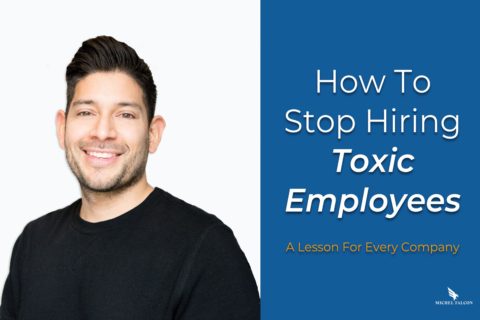We’ve all done it.
We hired someone who spoils our company culture. They spoil team alignment, alienate others and are typically only cordial to your company’s best clients.
I’ve mistakenly hired these people before. But today I have guidelines that greatly increases the likelihood that I won’t hire them again. I’ll be sharing these lessons with you in this blog post and you’ll learn:
- How to create better job descriptions to repel these people from even applying to your company.
- My two-step sign-off system for every hire. There’s a trick here that will likely be new to you.
- A sample of my interview process that has been replicated 100+ times by companies like yours.
Before making an offer to a team member, it’s important to understand the cost of a hiring toxic employee and familiarize yourself with red flags.
Cornerstone OnDemand created a report that shared the following data about hiring toxic employees:
- Good employees are 54% more likely to quit when they work with a toxic employee.
- By making their co-workers significantly more likely to leave, toxic employees lead to rising replacement costs; hiring a single toxic employee onto a team of 20 workers costs approximately $12,800. Whereas hiring a non-toxic employee costs an employer an average of $4,000.
- Toxic employees have a negligible effect on the performance of their co-workers. This suggests that they have a stronger influence on stress and burnout than on day-to-day task completion.
This indicates that not only are toxic employees hurting the company culture, but they are also negatively impacting financial results. If this won’t get the attention of every senior executive and director at your company, what will?
Before you put yourself and your company in a vulnerable position by hiring a toxic employee, consider these red flags.

Everyone can agree that hiring toxic employees is bad business. Now let’s explore why we still do it.
I think there are three key reasons why companies of all sizes continue to hire toxic employees:
- These employees “hit their numbers.” For example, a salesperson achieves their quarterly targets, a software engineer ships clean, high-quality code on-time or a digital marketer produces Facebook ads with a CPC of less than $0.10.
- We’re toxic too. Sometimes leaders attract like-minded individuals. This is one of the hardest questions we need to ask ourselves, “Am I an asshole too?”
- We don’t have guardrails in place to ensure that cultural misfits and toxic employees don’t even get a chance to join our companies.
Job Descriptions
Job descriptions should accurately represent what it’s like to work at an organization. These documents should clearly outline what’s most important to the company, how to be successful operating within it and what will alienate an employee.
Too often companies will go to Google, type in “job description template,” and plug and play. I’m not suggesting that using a template for benchmarking purposes is wrong. However, I am suggesting that before you use a template, ask yourself, “Who wrote it?” “Are they credible?” and “Do they have a similar company culture as mine?” If you can’t answer those questions confidently then don’t use it for something as important as hiring for your company.
Remember, your job description is the first impression that your company gives to new applicants and anyone looking to build a relationship with your company. This impression should align with the current state of your company culture. If your culture is performance-based, like Netflix, then have it read like that. If it’s more fun, like Zappos, then ensure the job description reflects that.
Use Warby Parker’s job description as an example. Notice how it reads? It’s welcoming, playful and sets clear expectations.
Also, it aligns with one of their core values, “Create an environment where employees can think big, have fun and do good.”
Most importantly, it includes language that should repel toxic employees, such as, “Along the way, you’ll partner with motivated, collaborative individuals who take their work (but not themselves seriously.”

Key Takeaway: review your job descriptions this week and ask yourself, “Does this document represent our brand well in order to repel toxic employees?”
Two-Step Sign-Off System
In any company I have ownership in or advise on, I implement a two-person sign-off system. Every person that is hired must be approved by at least two (often more) senior leaders within the company.
You’ve likely heard of the two-person sign-off system before but it’s what we sign-off on that is most important. Often, companies will sign-off on the candidate’s ability to perform the job at hand. This is important but what is equally as important, and perhaps even more important, is their ability to join the team, and contribute to company culture without being disruptive to what you’ve already built.
When it comes to the two-step sign-off system, I have found that it works well if you follow these steps:

Taunton Village Dental, the only client I still advise today (I retained this client after stepping away from consulting because the dental industry is tough and I like the challenge), is a real-world example of the two-step sign-off system working well. The dental practice needed to hire an associate dentist urgently. After a series of interviews, which included a working interview, the dental practice’s Director of Operations was prepared to make a candidate an offer.
Before making the hire, the Director of Operations met with her Treatment Coordinator (someone from a neighbouring department) asking for feedback on the hire. The Treatment Coordinator shared observations that she gathered from the working interview that indicated that the candidate would be toxic to the culture. After discussing these observations together they determined that it would be wrong to hire this candidate so they did not make an offer. Together, they reviewed the pool of candidates, aligned themselves and hired an associate dentist that they both agreed on.
Key Takeaway: Ensure that the two people signing-off on each new hire work in different departments. It works brilliantly!
The Proven Interview Process
Hospitality is known for many things, one of which is high employee turnover. In 2016, before I embarked in owning restaurants and bars in the city of Toronto, I knew that this would be a challenge to overcome so I built a regimented interview process.
Not only did this interview process help with improving our employee retention, but it also ensured that cultural misfits or toxic employees didn’t even get the chance to join us. I can’t say that we haven’t made a bad hire. However, I can confidently tell you that it has drastically improved the quality of candidates that we have made offers to. This interview process has been replicated by over one hundred companies such as Subway, Alfa Romeo, LUSH Cosmetics, and others. I teach my proven interview process through keynote speeches, workshops, and my book.
Pay close attention to the structure of the process. Notice how the culture interview happens before the skill set interview? Prior to gauging their skillset to the best of my ability, I want to learn how they will behave within our culture. At this point, what they have accomplished in the past isn’t as important as how they will contribute to our company culture in the future.

During our culture interview we follow these steps to identify toxic employees and remove them from the process:
- We probe for behaviours during times of turbulence by asking questions to better understand how they will lead or be led when things aren’t going well in the business.
- We don’t bring their resume to the culture interview. All you need to know is their name and position they are applying for. I don’t want the hiring manager to be enamored by their resume and ignore the fact that they could be toxic to our culture.
- We have five core values within our company (celebration, ownership, foresight, integrity, humility). For each core value, we ask two questions that help us identify whether or not the candidate will be a good fit for our company culture. It’s difficult to fake it over a series of 10+ questions
- If the candidate doesn’t pass the culture interview then we remove them from the interview process immediately. It doesn’t matter what their resume says or what their past accomplishments are. Our culture is too important to us.
Key Takeaway: Don’t allow yourself to gravitate towards the candidate’s resume and past accomplishments. Evaluate whether the candidate aligns with your company’s values and team members first.
A company can’t afford to have an imbalance between hiring for skills and hiring for camaraderie. According to the Center for American Progress, employee turnover can cost organizations anywhere from 16% to 213% of the lost employee’s salary. Follow the three suggestions I’ve listed and watch your hiring methodology improve, and finances increase.
Want more?
- Sign up for my free mini-course to learn more of my strategies. Click here to sign up for free.
- Learn about my online course, Team Operation System (tOS). Learn more about tOS here.
- Connect with me on Linkedin.
- Looking for a keynote speaker for your event? Learn more about my keynote speaking services here.

